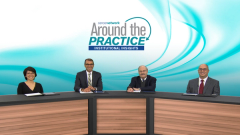
Treatment Response and Duration of Therapy in Transplant-Ineligible NDMM
Closing out their module on transplant-ineligible NDMM management, expert panelists consider best practices regarding duration of therapy and adjustments to drug regimens.
Episodes in this series

Transcript:
Alfred Garfall, MD: Let’s talk a bit about duration of therapy. We talked in the cases where we were planning stem cell transplant for patients about consolidation and maintenance therapy, but here’s a patient who’s not going to have that kind of demarcation of pretransplant and post-transplant therapy. This patient’s on Revlimid [lenalidomide] and daratumumab. Sandara, what are your thoughts on how long you’re going to continue this regimen? Do you imagine continuing both agents forever, switching to monotherapy at some point, or maybe even stopping therapy entirely in favor of observation?
Sandara Susanibar-Adaniya, MD: I think at this point we don’t have the data that will guide the decision. I will rely more on the toxicity profile. If the patient develops any type of toxicity and is in a very good response, I will be prone to stop the medication. But I don’t think that at this point the data are clear on when you need to stop treatment and also which patient will benefit the most from stopping treatment. I think a lot of the studies that are ongoing and trying to assess this question will provide key information in the next couple of years, but not now.
Alfred Garfall, MD: Yes, and we talked about the SWOG S1803 study earlier, daratumumab versus daratumumab and lenalidomide maintenance. That’s in the post-transplant setting, but a key component of that study is to take patients who have achieved MRD [minimal residual disease] negativity and randomize them to either stop therapy or continue therapy to see if maybe there is a subset of patients for whom indefinite therapy is clearly unnecessary, and we’ll get those data in due time. Meanwhile, Dan, what are your approaches for patients like this, who are on daratumumab and lenalidomide, not planning to go to transplant? Is it to continue indefinitely, switch to monotherapy, or consider stopping therapy?
Dan Vogl, MD: I think the first principle is to make sure that once you’ve achieved a very good response, you then turn the treatment regimen to something that’s going to be reasonably convenient and well tolerated for the patient. So, lowering the dose of lenalidomide to a very tolerable dose, and not necessarily continuing on the same dose indefinitely. The daratumumab on a standard regimen shifts to monthly dosing, which then becomes very convenient for the patient. I’m a big believer in both reducing the frequency and the dose of the steroid component of the regimen, and in many patients, eliminating steroids completely, even as a premedication for daratumumab. Both in clinical practice and even in some clinical trials, we’ve shown that we can do this completely safely so that the patient’s treatment then, even getting no premedications for daratumumab, becomes a very quick monthly office visit, which can be combined with regular monitoring of their laboratory tests. Lenalidomide continues as a low, tolerable oral medication at home, which is a regimen that patients can envision staying on for a long time. My tendency in that situation then is, if that regimen is indeed well tolerated and it’s continuing to work, I don’t think we’ve shown any advantage from stopping a treatment that’s working.
On the other hand, like Sandara, if the patient is having adverse effects, I very much believe in further lowering the dose of lenalidomide or stopping it completely. By the same token, if a patient has a strong preference to stop therapy and have a treatment-free interval, I think we can correctly tell our patients that we don’t know for sure that continuing therapy will lead to better outcomes. So that if a patient has a strong preference to stop therapy, I think it may be just as good to stop therapy. Patients who want to should be told that’s an OK thing to do. Although, I think our standard practice, in part based on the success of lenalidomide maintenance after autologous stem cell transplant in prolonging overall survival, we tend to apply that to other situations and think that ongoing continued therapy, especially with a lenalidomide-based regimen, is probably the right thing to do.
Edward Stadtmauer, MD: Most of the new medicines are from studies, and we’re usually studying it in a setting of patients who have relapsed and refractory disease. Of course, if we see someone who’s responding, we’re very hesitant to stop the medication. Most of our practice is to continue medicines. We’re sort of victims of the past, and of course in the past we didn’t have such effective regimens, and so continuing them…. I think the theme we’re all saying is, as patients are going on and on doing well, less is more. That minimizing toxicity, giving quality of life, the whole reason we’re doing this is to give people long, happy lives, and so no need to keep pounding them with toxicity.
Alfred Garfall, MD: I think that’s a great concluding comment. I want to thank my fellow faculty for joining us in this lively discussion on the treatment of patients with multiple myeloma, brought to you by the CancerNetwork®.
Thank you to our viewing audience. We hope that you found this interactive discussion to be informative and beneficial to your clinical practice.
Transcript edited for clarity.
Newsletter
Stay up to date on recent advances in the multidisciplinary approach to cancer.





















































































